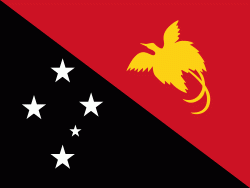Papua New Guinean kina
K
The Kina (ISO 4217 currency code: PGK, the currency symbol: K) is the currency of Papua New Guinea. It is divided into 100 toea. The name Kina is derived from Kuanua language of the Tolai region, referring to a callable pearl shell used widely for trading in both the Coastal and Highlands areas of the country.The kina was introduced on 19 May 1975 and circulated along with the Australian dollar until 31 December 1975. The two currencies were equal in value (K1 = A$1). The next day, the dollar ceased to be legal tender in Papua New Guinea.
The kina has been a historically stable currency; the economy has never experienced exorbitant rates of monetary inflation.
During its early years, the kina experienced an appreciation relative to the Australian dollar, reaching a value of approximately A$1.30 in 1980. The kina reached a peak relative to the Australian dollar in 1986 (K1 = A$1.54). The kina remained stable until 1995, when the country started experiencing double-digit annual rates of inflation, causing its value to drop gradually. The kina fell below the Australian dollar in 1996. Elevated rates of inflation persisted, and by 2002, the value of the kina fell below A$0.50. For most of the time since then, with the exception of between September 2008 and March 2009, the kina traded below A$0.50.
The average exchange rate of one kina in September 2022 was: K1 = US$0.2840, which means that US$1 = K3.52.
Country
-
Papua New Guinea
Papua New Guinea (abbreviated PNG;, also ), officially the Independent State of Papua New Guinea (Independen Stet bilong Papua Niugini; Independen Stet bilong Papua Niu Gini), is a country in Oceania that comprises the eastern half of the island of New Guinea and its offshore islands in Melanesia (a region of the southwestern Pacific Ocean north of Australia). Its capital, located along its southeastern coast, is Port Moresby. The country is the world's third largest island country, with an area of 462840 km2.
At the national level, after being ruled by three external powers since 1884, including nearly 60 years of Australian administration starting during World War I, Papua New Guinea established its sovereignty in 1975. It became an independent Commonwealth realm in 1975 with Elizabeth II as its queen. It also became a member of the Commonwealth of Nations in its own right.
